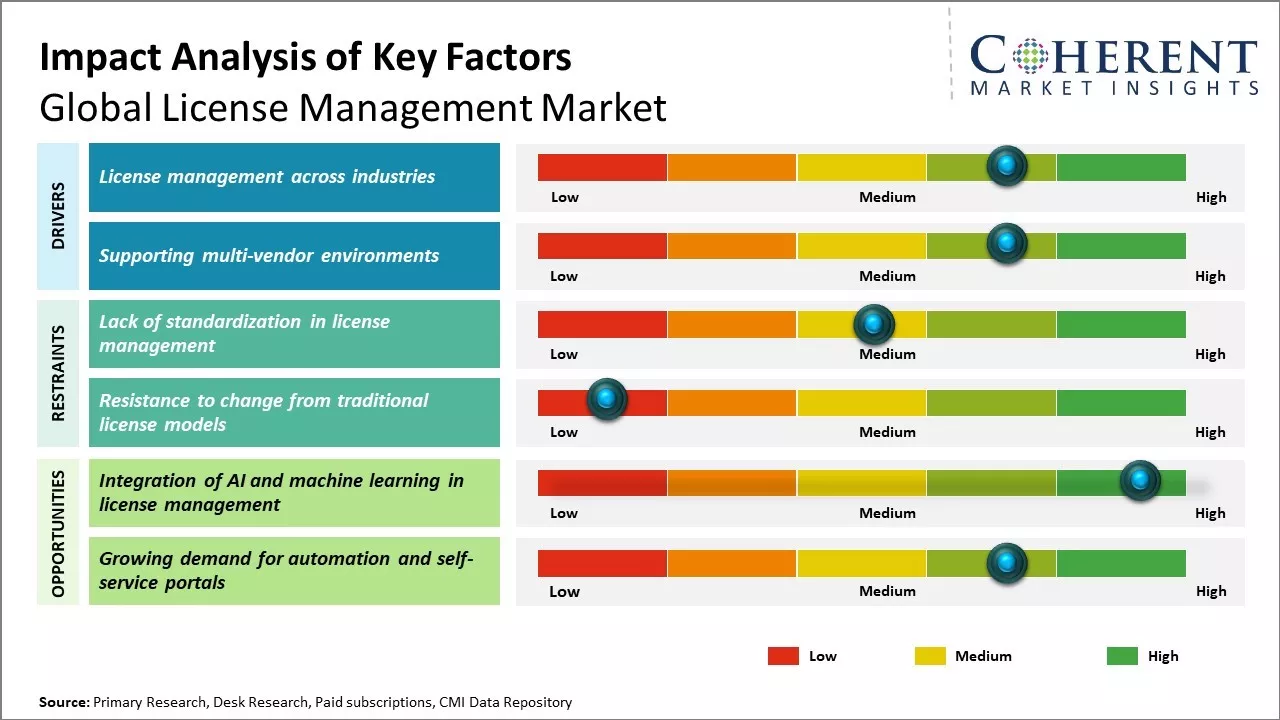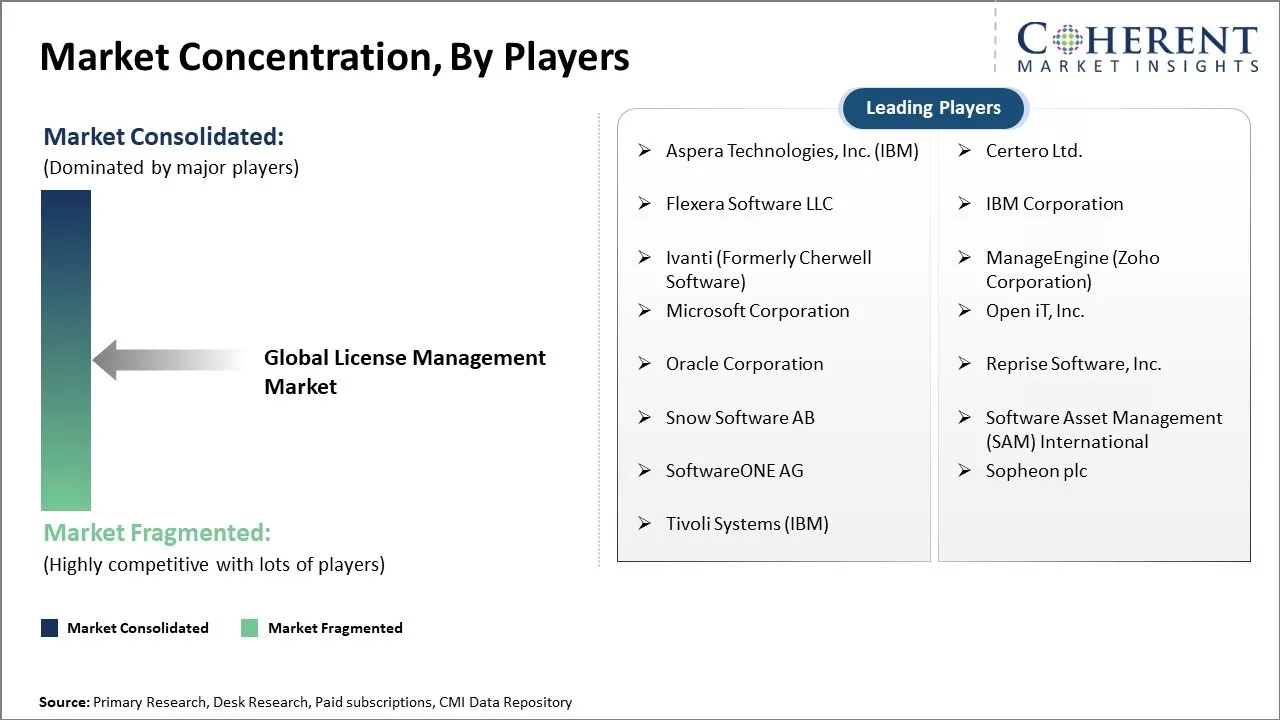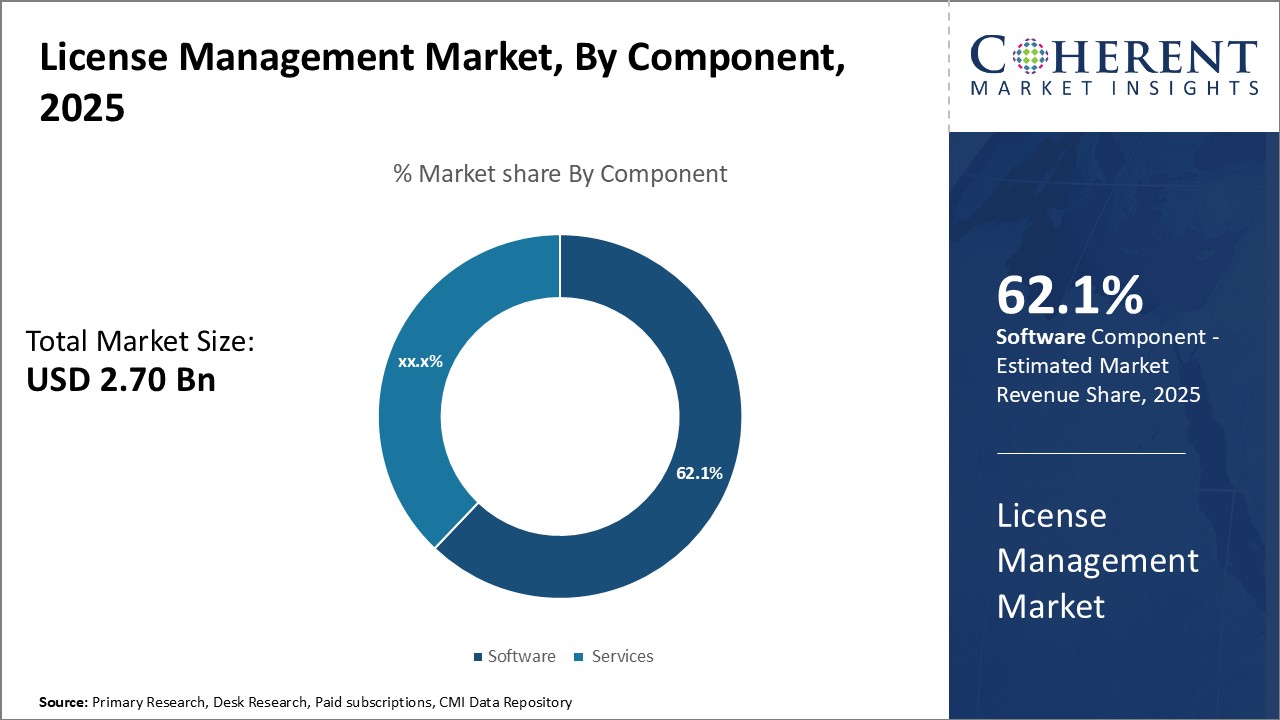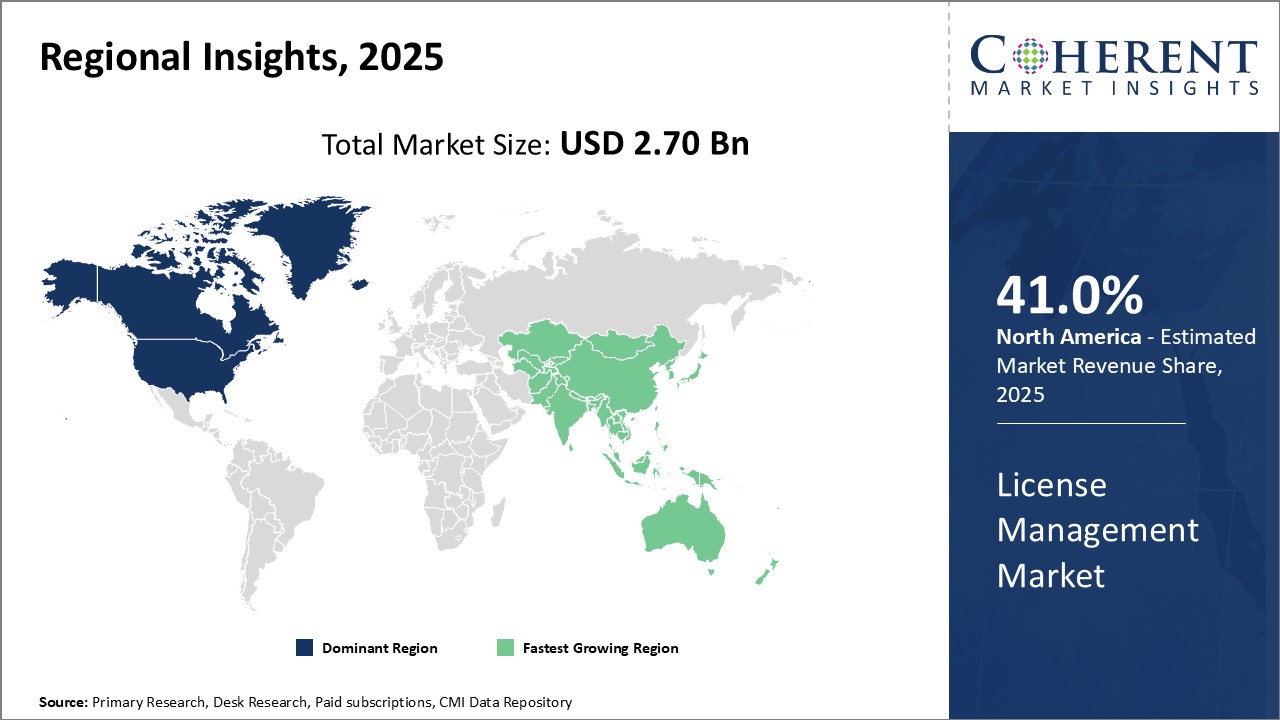Global license management market is estimated to be valued at US$ 2.70 Bn in 2025 and is expected to reach US$ 5.64 Bn by 2032, exhibiting a compound annual growth rate (CAGR) of 11.1% from 2025 to 2032. The market growth is primarily driven by rising need for monitoring and controlling software licenses across various industries. With increasing adoption of cloud-based solutions and SaaS applications, there will be huge demand for centralized license management.

Discover market dynamics shaping the industry: Download Free Sample
Increasing stringent regulations around software license compliance and focus toward optimizing IT spending can boost adoption of license management solutions. Furthermore, rising frequency of software audits and focus on gaining visibility across heterogeneous licensing environments can also boost demand for advanced license management solutions.
License management across industries
With the ever-growing digital transformation of industries, companies across all sectors are increasingly relying on complex software and tools from various vendors. This has led to increase in the number of software licenses that organizations need to manage on a daily basis. From CRM and ERP systems to specialized engineering and design tools, modern businesses utilize a whole host of applications, each with its own set of licenses. Keeping track of all these licenses, ensuring compliances, and optimizing usage has become a challenge for IT departments. This boosts demand for license management solutions as more companies realize the need for dedicated license management software and services.

Get actionable strategies to beat competition: Download Free Sample
Supporting multi-vendor environments
Growing need to manage licenses from multiple software vendors through a single platform can drive the market growth. Earlier, organizations would typically deploy solutions from one or two key vendors in their environment. However, nowadays firms leverage tools from a wide array of providers to meet diverse business needs. This has drastically increased the license administration overhead. Managing licenses from dozens of different vendors using spreadsheets and disjointed processes is an ineffective and error-prone approach. Vendors in the license management market are helping companies to overcome this challenge by offering integrated platforms that provide a consolidated view of all licenses alongside efficient usage monitoring and compliance for every vendor in the IT landscape. This is proving valuable for enterprises and boosts spending on license management capabilities.
Key Takeaways from Analyst:
Global license management market growth is driven by growing concerns about software license compliance and optimization among organizations. Strict software licensing policies by major technology vendors also prompt enterprises to closely monitor and manage their software licenses.
North America dominates the market, owing to stringent regulatory environment regarding software licensing. However, Asia Pacific is projected to emerge as the fastest growing regional market due to rapid digital transformation of industries in China and India.
Adoption of flexible licensing models like subscription-based licensing by vendors makes license management more critical for organizations. Maintaining visibility across hybrid cloud environments is a major challenge for license managers. Integrating license data from different software tools and managing bring own license scenarios will also be a key focus area.
Market Challenges: Lack of standardization in license management
Lack of standardization in license management can hamper the global license management market growth. When there is no standard process or platform for license management across organizations, it leads to several operational challenges. Without a standardized and structured approach, organizations have to rely on multiple systems and methods to track software licenses. This leads to inefficiencies, errors and excessive costs associated with license reconciliation, compliance and optimization. With differing license management protocols in place, it also becomes difficult for organizations to get a unified view of their license portfolios. This fragmented nature of license management hampers strategic decision-making regarding asset allocation, procurement planning and risk management.
This lack of cohesion and uniformity in license management processes can pose challenges for audits. Software auditors usually follow strict guidelines and standardized protocols to examine license compliance. However, in the absence of a set structure, audits take longer and become an arduous task. It increases the likelihood of non-compliance issues. This can lead to expensive penalties and lawsuits.
Market Opportunities: Integration of AI and machine learning in license management
The integration of artificial intelligence and machine learning technologies can offer growth opportunities for the global license management market. AI can help organizations automate previously manual tasks related to license procurement, allocation and compliance. Using machine learning algorithms, license usage patterns can be analyzed over time to optimize licensing agreements and budgets. This brings greater visibility into license holdings and deployments across different business units and geographies.
AI-powered auditing solutions can continuously monitor all endpoints to track software and detect any anomalies in real-time. This helps ensure adherence to licensing terms by identifying unlicensed installations or mismatched configurations. At the same time, customer experience is enhanced as AI assists in automating routine queries regarding licenses. Dialogflow and Alexa-enabled voice assistants can remotely help users with license requests, installations and troubleshooting issues. Such virtual support aids are becoming increasingly valuable amid hybrid work setups.
As organizations transition to cloud-first models, there has been rising need for flexible license management of SaaS applications and virtual desktop infrastructure. AI plays a key role by facilitating usage-based licensing through cloud-metering and consumption-based billing. Data gathered from cloud platforms is analyzed to only pay for what is consumed, improving operational efficiency, compliance and cost savings.

Discover high revenue pocket segments and roadmap to it: Download Free Sample
Insights By Component- Software segment dominates due to its essential role in license management
In terms of component, software segment is expected to contribute the highest market share of 62.1% in 2025, owing to its critical functionality in automating the entire license management process. Licenses for various software applications, development tools and platforms have become core assets for most businesses. Sophisticated software solutions have become indispensable for efficiently managing the lifecycle of these licenses, from acquisition and allocation to compliance and renewal. These help organizations track software usage, optimize license procurement, remain compliant with software publisher agreements, and save costs by avoiding over-procurement. With software licenses proliferating across enterprises, there has been rising need for automated tools to centrally govern these assets. Software solutions provide capabilities like inventory discovery, optimization of license allocation, flexible deployment models, and integration with other IT systems. Their comprehensive feature sets address diverse requirements of license management at both technical and business levels, making them irreplaceable for most organizations.
Insights By Deployment- Cloud-based solutions lead due to operational flexibility
In terms of deployment, cloud-based segment is expected to contribute the highest market share of 55% in 2025, owing to agility and scalability it offers. License management requires access to usage data and reports across the distributed IT infrastructure of global enterprises. Cloud-deployed solutions resolve the challenges of on-premises systems in administering software licenses spanning multiple locations, teams and devices. These provide a centralized platform for online license request, allocation and reconciliation without dependency on local hardware or networks. With Software-as-a-Service models, vendors manage software, infrastructure and support, reducing maintenance costs for customers. This operational flexibility enables businesses to align their license needs more dynamically based on adoption and project timelines. It also frees up in-house IT resources for strategic tasks. Furthermore, multi-tenant cloud architectures deliver automation and analytics capabilities on-demand, empowering license portfolio optimization in real-time based on analytics of usage patterns.
Insights By End-use Industry- Healthcare Utilizes Licenses Extensively
In terms of end-use industry, healthcare segment is expected to contribute the highest market share of 46.2% in 2025, owing to its extensive usage of licensed software products and platforms. Digital innovation is massively transforming healthcare delivery as well as research and clinical functions. Various types of medical software including electronic health records, patient engagement, medical imaging, hospital management systems and bioinformatics have become critical tools empowering the industry. Their adoption levels have proliferated across healthcare providers, biotech/pharma firms, research institutes and insurance payers, boosting demand for optimized license procurement and governance. Strict regulatory compliances around data privacy and security have made auditable software asset management a top priority. Healthcare organizations require high degrees of license visibility, control and compliance to demonstrate regulatory adherence for their licensed clinical and research systems. Comprehensive license management helps them streamline software approvals, stay updated on changes to publisher agreements and avoid non-compliance risks and penalties.

Need a Different Region or Segment? Download Free Sample
North America dominates the global license management market, with an estimated market share of 41.0% in 2025. The region has strong presence of major technology companies and consulting firms who are actively using license management solutions for their diverse software and product portfolios. With large technology industry and early adoption of digitization among enterprises, there has been huge demand for automated software licensing management. In U.S., software license management is a big part of enterprise IT budgets with organizations trying to optimize compliance and costs associated with software assets. The pricing models offered by license management vendors also suit large North American enterprises focusing on return-on-investment for their IT projects.
The Asia Pacific region has emerged as one of the fastest growing markets for license management globally. Several gulf countries in the region have recognized intellectual property rights, and are investing heavily in digitization of their economies. Multinational companies from developed markets have expanded operations in the Middle East and North Africa, bringing their diverse technology requirements. This growing industry presence requires centralized software management to meet organizational and legal license needs across borders. Africa has witnessed rise in startup culture and focus on developing knowledge economies, driving the uptake of subscription-based license management platforms. The pricing and implementation models offered by vendors have helped license solutions gain traction among both large enterprises as well as small and medium businesses in the region.
License Management Market Report Coverage
| Report Coverage | Details | ||
|---|---|---|---|
| Base Year: | 2024 | Market Size in 2025: | USD 2.70 Bn |
| Historical Data for: | 2020 To 2024 | Forecast Period: | 2025 To 2032 |
| Forecast Period 2025 to 2032 CAGR: | 11.1% | 2032 Value Projection: | USD 5.64 Bn |
| Geographies covered: |
|
||
| Segments covered: |
|
||
| Companies covered: |
Aspera Technologies, Inc. (IBM), Certero Ltd., Flexera Software LLC, IBM Corporation, Ivanti (Formerly Cherwell Software), ManageEngine (Zoho Corporation), Microsoft Corporation, Open iT, Inc., Oracle Corporation, Reprise Software, Inc., Snow Software AB, Software Asset Management (SAM) International, SoftwareONE AG, Sopheonplc, and Tivoli Systems (IBM) |
||
| Growth Drivers: |
|
||
| Restraints & Challenges: |
|
||
Uncover macros and micros vetted on 75+ parameters: Get instant access to report
*Definition: Global License Management Market involves solutions that help organizations track and manage software licenses from major vendors across all locations. These solutions provide visibility into software assets and usage, help avoid compliance issues and costs of license overuse, and optimize license procurement. These automate various tasks around license allocation, reconciliation of licenses with install base, and generation of reports for audits. The license management market aims to help organizations effectively manage their software assets at a global level.
Share
Share
About Author
Suraj Bhanudas Jagtap is a seasoned Senior Management Consultant with over 7 years of experience. He has served Fortune 500 companies and startups, helping clients with cross broader expansion and market entry access strategies. He has played significant role in offering strategic viewpoints and actionable insights for various client’s projects including demand analysis, and competitive analysis, identifying right channel partner among others.
Missing comfort of reading report in your local language? Find your preferred language :
Transform your Strategy with Exclusive Trending Reports :
Frequently Asked Questions
Joining thousands of companies around the world committed to making the Excellent Business Solutions.
View All Our Clients